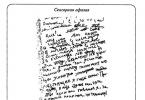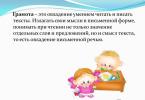OKOF of gasoline power plants is a list of names and codes recorded in the all-Russian classifier of fixed assets. A distinction is made between thermal energy generators and other fuel devices. Each of them differs in purpose and configuration, power and scope. Before we talk about generators with gasoline engines according to OKOF, let’s figure out why power plants are needed at all.
Classifier of gasoline and diesel power plants
Power plants driven by a diesel or gasoline engine have a wide power range. They will be able to provide electricity to any facility. From a roadside cafe to an oil field. We need autonomous sources of electricity everywhere. In rural areas and holiday villages, small similar units are widely used.
These small gasoline power plants according to OKOF are identified by assigned codes. Different numbers indicate the purpose of the units. For example:
- 300.00.00.00.000 - equipment and household supplies at the enterprise;
- 330.00.00.00.000 - other machines intended for use at business facilities;
- 330.28 - machines that are not included in other lists of units;
- 330.28.2 - power plants for general purposes and applications;
- 330.28.29 - other types of machines and units under study that are not included in any other categories of characteristics.
According to OKOF, the gasoline power plant can be used both for general purposes and in the industrial and mining segment.
The heart of the unit’s motor: what’s special about them?
Small devices can be transported in the trunk of a car. They will always provide the necessary electrical power. And it will be enough to connect lighting and a TV, a water pump, a refrigerator and other household devices. When more electricity is required, diesel engines replace gasoline engines. Almost all mobile power plants with a power of 20 kW and above have a diesel drive.
This engine has a number of advantages:
- unpretentiousness to fuel quality;
- reliability;
- fuel consumption;
- long service life before major overhaul.
For a gasoline power plant according to OKOF number 330.28.29, a power of 20-25 kW is sufficient to ensure the operation of a small roadside canteen or hotel.
Specialized machine applications
Large diesel engines for power plants of 1000 kW and more are produced in Russia and foreign countries. These are extremely economical and reliable engines. Combined into one unit with a generator, they have become most widespread and popular. Powerful gasoline power plants with code OKOF 330.00.00.00.000 are very powerful and durable. Experts note that they do not require major repairs for several years and do not require frequent replacement of components. At the same time, electricity is generated uninterruptedly.

The main condition for such operation is compliance with technical regulations.
A modern diesel power plant is the basis for mobile electricity generation
In remote regions of Russia, diesel power plants are the main source of electrical energy both in everyday life and in industry. Thousands of cities and villages receive electricity from these sources. Mines, mines, dredge sites, processing plants, military units and other facilities - all use electricity generated by powerful diesel generators.

These capacities also play a huge role where there is a centralized energy supply. Gasoline generators with OKOF 143149010 in the classifier 140000000 autonomous power supply are irreplaceable as backup and emergency sources of power supply. They are present at all important sites:
- Administrations and control points.
- Nuclear, thermal and hydroelectric power plants.
- Medical complexes.
- Information storage and processing centers.
- Telecommunication centers.
- Radio and TV stations.
- Large factories and storage facilities.
- Airports.
- Banks, large shopping and entertainment centers.
- Military units, places of detention and other facilities.

Mobile power plants with a capacity of up to 25 kW are indispensable during the liquidation of natural disasters. The domestic industry has mastered the production of powerful diesel units that do not require diesel fuel. They can run on natural gas and crude oil. This speeds up the development of remote oil and gas fields tenfold.
Question to the auditor
In connection with the transition from January 1, 2017 to the use of the new All-Russian Classifier of Fixed Assets (OKOF), the program replaced the codes for fixed assets that were on the balance sheet before 01/01/2017.
What OKOF codes should be assigned to the listed fixed assets if the new classifier does not have a suitable grouping:
- household refrigerators – code 16 2930100;
- household kitchen electric stoves – code 16 2930122;
- electrical appliances for cooking - code 16 2930139;
- household washing machines – 16 2930200;
- diesel generator – code 14 2911106;
- electric player - code 14 3230164;
- power supply - code 14 3222182;
- domestic air conditioners - code 16 2930274.
On January 1, 2017, a new All-Russian Classifier of Fixed Assets, approved. by order of Rosstandart dated 12/12/2014 No. 2018-st(hereinafter referred to as OK 013-2014 (SNS 2008). All-Russian classifier of fixed assets OK-013-94, approved by resolution of the State Standard of Russia dated December 26, 1994 No. 359(hereinafter referred to as OK 013-94), has become invalid.
Fixed asset items accepted for accounting before January 1, 2017 are grouped in accordance with OK 013-94. Useful life and depreciation group established in accordance with the Classification, approved. Decree of the Government of the Russian Federation dated 01/01/2002 No. 1 in ed. until 01/01/2017 (hereinafter referred to as Classification) do not change.
Objects of fixed assets accepted for accounting from January 1, 2017 are grouped in accordance with OK 013-2014 (SNA 2008). Their useful life is determined according to the Classification as amended, which is valid from 01/01/2017.
In order to transition to the use of the new classifier, by order of Rosstandart dated 04/21/2016 No. 458 direct and reverse keys between editions of OKOF have been developed. In case of contradictions in the application of transitional keys, as well as the absence of positions in OK 013-2014 (SNA 2008) for accounting objects that, according to their criteria, are fixed assets, the institution’s commission for the receipt and disposal of assets independently assigns the objects to the corresponding group of codes OK 013- 2014 (SNA 2008) and determines the useful life.
The principles for grouping objects in the new and old OKOF are different. The new OKOF is focused on the production sector, so it does not contain fixed assets intended for household needs. If it is not possible to identify an object in the new classifier of fixed assets, it is necessary to use the approach that was used in the previously valid classification.
Since the OKOF code will subsequently be used in the preparation of statistical reporting, the old code cannot be left. Therefore, it is necessary to assign a code to the fixed asset object that is at least remotely suitable for the object (conditional).
Thus, it can be recommended that a budgetary institution assign the following codes according to OK 013-2014 (SNA 2008) to the fixed assets listed in the question:
- refrigerators – code 330.28.25.13.119 “Other refrigeration equipment”;
- electric stoves - code 330.28.21.13.129 "Other induction or dielectric heating equipment, not included in other groups" or 330.28.93.15.122 "Cooking stoves";
- electrical appliances - since the definition of “electrical appliances” is very capacious, one of the proposed options may be code 330.26.51.66 “Instruments, instruments and machines for measurement and control, not included in other groups”;
- washing machines – code 330.28.94.22.110 “Washing machines for laundries”;
- diesel generator – code 330.28.29.11.110 “Generators for producing generator or water gas” or 330.30.99.10 “Other transport vehicles and equipment not included in other groups” (the classification of a diesel generator as a fixed asset closer in value is not considered possible);
- electric player - code 320.26.30.11.190 "Other communication transmitting equipment with receiving devices, not included in other groups" or 330.26.30.1 "Communication equipment, radio or television transmitting equipment";
- power source - code 330.26.51.66 "Instruments, instruments and machines for measurement and control, not included in other groups";
- Domestic air conditioners - code 330.28.25.12.190 "Other air conditioning equipment, not included in other groups."
Despite the fact that the listed objects belong to the same type - “Other machinery and equipment, including business equipment, and other objects” (according to the new OKOF), - in accounting they must be accounted for in accounts 101 04 and 101 06 in the same manner.
The OKOF classification system is necessary to determine the fixed assets of an enterprise. It contains codes of tangible and intangible assets in an international format, by which the composition of the fixed assets can be assessed.
For tangible assets, and, in particular, for technical equipment, a classification according to useful life is additionally introduced. According to this criterion, all mechanisms are distributed into ten depreciation groups. Depending on which depreciation group the equipment falls into, the tax amount is calculated.
What does OKOF represent for generating sets and how is the depreciation group determined?
OKOF of a diesel generator can be determined in two ways:
- Classification into the subclass “Autonomous power supply sources” 14 3149000. Then OKOF for a diesel generator will be 14 3149010 “Mobile power stations, gasoline units, diesel generators.”
- Assignment to the subclass “Internal combustion engines, with compression ignition (diesels, diesel generators)” 142911100. In this case, OKOF is selected from six options (the last digit of the code is from 1 to 6) depending on the diameter of the cylinders.
In controversial situations, as in the case of diesel generators, the accountant can independently choose the subclass.
The depreciation group is selected according to the regulatory document “Classification of fixed assets included in depreciation groups” dated January 1, 2002 N1. It is necessary to constantly clarify the edition, since the document is often updated.
Based on the OKOF of the diesel generator, the group is determined as follows:
- We find the OKOF of the generator - for example, let's take 14 3149010. The subclass code will then be 14 3149000.
- In the classifier of fixed assets, we are looking for subclass 14 3149000 - it falls into depreciation group 5, with the exception of generators with codes 14 3149130 (“Mobile power plants”) and 14 3149140 (“Electric power units”). Accordingly, the useful life of such equipment will be from 7 to 10 years.



